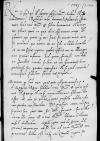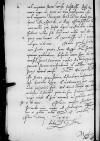Reddidit mihi dominus palatinides Pomeraniae[1] ⌊⌋ Vestrae Reverendissimae Paternitatis solita humanitate et benignitate plenas, quas ea qua decet observantia accepi et plurimas ago gratias, quod mei, servi sui minime meriti, non sit immemor. Quo nomine ita me sibi reddidit devinctum, ut mecum saepius cogitem, quibus officiis me in illius gratiam penitius insinuem. Sed cum fortasse non dabitur facultas, curabo saltem, ut me humanitatis benignitatisque suae gratum cognoscat et, si quid curandum commiserit, fidelem servum experiatur.
Demiror, quod litterae meae, quas ante aliquot menses per dominum Gregorium Raw, subditum Vestrae Reverendissimae Paternitatis, quem ipsamet et ⌊principi⌋, et mihi commendaverat, dederam, tantisper illi non sint ms. sit(!)
⌈sintsint ms. sit(!)
⌉t redditae, quas profecto redditas esse iam pridem existimabam. Et prolixe omnia eis prosecutus sum, quae tum hic acta fuerant. Fuere etiam nonnulla, quae Paternitatem Vestram Reverendissimam libenter lecturam nihil dubitabam. Cum igitur nunc de homine diligentius inquirerem, ubi sit, cur ad Vestram Reverendissimam Paternitatem non pervenerit, dictum est mihi eum coronae negotii sui  BCz, 1599, p. 516 vel nepotum suorum causa substitisse. Atque ita unice rogo, ne putet me tam neglegentem esse vel magnorum virorum litteras ad me datas parvi facere. Respondi, ut dixi, officiosissime, etiam hidden by binding⌈[iam]iam hidden by binding⌉ nonnulla, quae scriptu digna existimabam, adiunxi hidden by binding⌈[i]i hidden by binding⌉. Iubeat velim sibi litteras meas reddi, nam illa repetere non vacat et excidisse iam e memoria aliqua videntur.
BCz, 1599, p. 516 vel nepotum suorum causa substitisse. Atque ita unice rogo, ne putet me tam neglegentem esse vel magnorum virorum litteras ad me datas parvi facere. Respondi, ut dixi, officiosissime, etiam hidden by binding⌈[iam]iam hidden by binding⌉ nonnulla, quae scriptu digna existimabam, adiunxi hidden by binding⌈[i]i hidden by binding⌉. Iubeat velim sibi litteras meas reddi, nam illa repetere non vacat et excidisse iam e memoria aliqua videntur.
Nunc quod scribam non habeo, praeter sacrae ⌊regiae maiestatis iunioris⌋ optimam valetudinem, discedet autem hinc die nona mensis huius ⌊Cracoviam⌋ versus serenissimorum ⌊principum hidden by binding⌈[m]m hidden by binding⌉⌋ parentum suorum invisendorum et nonnullorum negotiorum hidden by binding⌈[um]um hidden by binding⌉ suorum obeund causa. Serenissima ⌊reginalis maiestas ista iunior⌋ gravissima distinebatur infirmitate ab hidden by binding⌈[b]b hidden by binding⌉ ipsa Dominica Laetare et recidivaverat bis iamque morti proxima fuit. Sed Deus omnipotens ope et opera hidden by binding⌈[era]era hidden by binding⌉ medicorum destitutam potentia sua servavit nobis [...] hidden by binding⌈[...][...] hidden by binding⌉ recipit vires et heri cenavit in publico, servitum hidden by binding⌈[m]m hidden by binding⌉ est on the margin⌈estest on the margin⌉ ⌊ei⌋ de more.
Plura nequeo scribere, nam hidden by binding⌈[am]am hidden by binding⌉ secundo iam vocor ad ⌊principem⌋.
Commendo hidden by binding⌈[o]o hidden by binding⌉ me in gratiam Vestrae Reverendissimae Paternitatis.
 BCz, 1599, p. 516 vel nepotum suorum causa substitisse. Atque ita unice rogo, ne putet me tam neglegentem esse vel magnorum virorum litteras ad me datas parvi facere. Respondi, ut dixi, officiosissime, etiam hidden by binding⌈[iam]iam hidden by binding⌉ nonnulla, quae scriptu digna existimabam, adiunxi hidden by binding⌈[i]i hidden by binding⌉. Iubeat velim sibi litteras meas reddi, nam illa repetere non vacat et excidisse iam e memoria aliqua videntur.
BCz, 1599, p. 516 vel nepotum suorum causa substitisse. Atque ita unice rogo, ne putet me tam neglegentem esse vel magnorum virorum litteras ad me datas parvi facere. Respondi, ut dixi, officiosissime, etiam hidden by binding⌈[iam]iam hidden by binding⌉ nonnulla, quae scriptu digna existimabam, adiunxi hidden by binding⌈[i]i hidden by binding⌉. Iubeat velim sibi litteras meas reddi, nam illa repetere non vacat et excidisse iam e memoria aliqua videntur.

